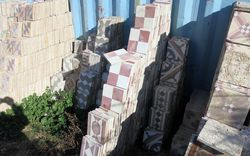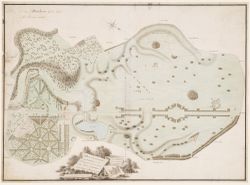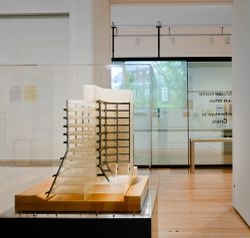documents textuels
AP197.S1.SS9.015
Description:
The box contains drafts, final copies, correspondence and notes for various articles, book projects, interviews, keynote addresses, and lectures by Kenneth Frampton. The materials are organized in alphabetical order, from I-K. The largest portion of this box consists of: drafts and transcripts of interviews with Kenneth Frampton; drafts, articles, correspondence and research materials for an unpublished book project on Japanese Building Practices/Japanese Contemporary Architecture; correspondence and drafts for the Jerusalem Seminar in Architecture; and correspondence and notes for a Panos Koulermos book project. Other subjects and architects explored in these texts include Arata Isozaki, Kritsin Jaramund, Michael Kagan, Louis Kahn, Rem Koolhaas, Kengo Kuma, and Kisho Kurakawa.
1985-2016
Kenneth Frampton writings (I-K)
Actions:
AP197.S1.SS9.015
Description:
The box contains drafts, final copies, correspondence and notes for various articles, book projects, interviews, keynote addresses, and lectures by Kenneth Frampton. The materials are organized in alphabetical order, from I-K. The largest portion of this box consists of: drafts and transcripts of interviews with Kenneth Frampton; drafts, articles, correspondence and research materials for an unpublished book project on Japanese Building Practices/Japanese Contemporary Architecture; correspondence and drafts for the Jerusalem Seminar in Architecture; and correspondence and notes for a Panos Koulermos book project. Other subjects and architects explored in these texts include Arata Isozaki, Kritsin Jaramund, Michael Kagan, Louis Kahn, Rem Koolhaas, Kengo Kuma, and Kisho Kurakawa.
documents textuels
1985-2016
archives
Niveau de description archivistique:
Fonds
John C. Parkin fonds
AP018
Résumé:
The John C. Parkin fonds documents the professional career of Toronto-based architect John C. Parkin (1922-1988) at his firms John B. Parkin Associates and Parkin Architects Planners. Most materials in this fonds record 347 architectural projects covering the years 1947-1987. John C. Parkin’s professional involvement in the arts and architecture, his firms’ activities, and his professional achievements are also recorded.
1929-1987
John C. Parkin fonds
Actions:
AP018
Résumé:
The John C. Parkin fonds documents the professional career of Toronto-based architect John C. Parkin (1922-1988) at his firms John B. Parkin Associates and Parkin Architects Planners. Most materials in this fonds record 347 architectural projects covering the years 1947-1987. John C. Parkin’s professional involvement in the arts and architecture, his firms’ activities, and his professional achievements are also recorded.
archives
Niveau de description archivistique:
Fonds
1929-1987
archives
Niveau de description archivistique:
Fonds
Fonds Umberto Riva
AP180
Résumé:
The Umberto Riva fonds documents Riva’s work as an architect and designer, predominantly in Italy, between the 1960s to the early 2010s. Included are drawings related to over 80 architectural projects, furniture designs, and exhibition designs.
1959-2012
Fonds Umberto Riva
Actions:
AP180
Résumé:
The Umberto Riva fonds documents Riva’s work as an architect and designer, predominantly in Italy, between the 1960s to the early 2010s. Included are drawings related to over 80 architectural projects, furniture designs, and exhibition designs.
archives
Niveau de description archivistique:
Fonds
1959-2012
archives
Niveau de description archivistique:
Fonds
Fonds Douglas C. Simpson
AP076
Résumé:
The Douglas C. Simpson fonds documents Simpson's 1938 graduation thesis project, residential projects from early in his career in Ottawa, furniture projects, and residential and commercial projects in British Columbia including those by the firm Semmens, Simpson. The fonds is composed primarily of drawings and photographs dating from 1938-1992, with the bulk of the documents ranging from ca. 1940 to ca. 1960.
1938-1992, [predominant ca. 1940-ca. 1960]
Fonds Douglas C. Simpson
Actions:
AP076
Résumé:
The Douglas C. Simpson fonds documents Simpson's 1938 graduation thesis project, residential projects from early in his career in Ottawa, furniture projects, and residential and commercial projects in British Columbia including those by the firm Semmens, Simpson. The fonds is composed primarily of drawings and photographs dating from 1938-1992, with the bulk of the documents ranging from ca. 1940 to ca. 1960.
archives
Niveau de description archivistique:
Fonds
1938-1992, [predominant ca. 1940-ca. 1960]
archives
Niveau de description archivistique:
Fonds
Fonds Barry Downs
AP077
Résumé:
The Barry Downs fonds contains 6 drawings and 8 presentation panels for a total of 11 projects conceived between 1956 and 1968. This period coincided with Down's position as design architect for Thompson, Berwick, Pratt & Partners, and his subsequent partnership with Fred Thornton Hollingsworth. The documents, particularly the drawings, reveal the considerable skill Downs possessed as both a draughtsman and a designer.
[1956-1968]
Fonds Barry Downs
Actions:
AP077
Résumé:
The Barry Downs fonds contains 6 drawings and 8 presentation panels for a total of 11 projects conceived between 1956 and 1968. This period coincided with Down's position as design architect for Thompson, Berwick, Pratt & Partners, and his subsequent partnership with Fred Thornton Hollingsworth. The documents, particularly the drawings, reveal the considerable skill Downs possessed as both a draughtsman and a designer.
archives
Niveau de description archivistique:
Fonds
[1956-1968]
archives
Niveau de description archivistique:
Fonds
AP128
Résumé:
The Harold Ship Alexis Nihon Plaza and Nuns’ Island Master Plan project records, (1956- 1973), document architect Harold Ship’s design and plan for the Alexis Nihon Plaza (1956-1965) and the Nun’s Island Master Plan (1959-1973). Materials in these project records consist of 1 619 drawings (including reprographic copies), 330 photographs, 5 l.m. of textual records, 5 models and 2 panels.
1956-1973
Documents d’archives de Harold Ship pour les projets de la Place Alexis Nihon Plaza et du plan directeur de L’Île-des-Sœurs
Actions:
AP128
Résumé:
The Harold Ship Alexis Nihon Plaza and Nuns’ Island Master Plan project records, (1956- 1973), document architect Harold Ship’s design and plan for the Alexis Nihon Plaza (1956-1965) and the Nun’s Island Master Plan (1959-1973). Materials in these project records consist of 1 619 drawings (including reprographic copies), 330 photographs, 5 l.m. of textual records, 5 models and 2 panels.
archives
Niveau de description archivistique:
Fonds
1956-1973
articles
Mondes matériels
Rotor, point supreme, Konstantinos Pantazis, Maarten Gielen, récupération, réutilisation, recyclage, matériaux
3 novembre 2017
archives
Niveau de description archivistique:
Fonds
Fonds Chuck Hoberman
AP165
Résumé:
The Chuck Hoberman fonds documents Hoberman’s work in transformable design throughout the first part of his career, from 1980 to 2006, as well as the operations of his company Hoberman Associates Inc. Materials relate to the research and development of design concepts, the patenting of inventions, detailed drawings for certain unfolding structures, the workings and movements of mechanisms, public presentations at fairs and exhibitions, and media coverage.
circa 1980-2006
Fonds Chuck Hoberman
Actions:
AP165
Résumé:
The Chuck Hoberman fonds documents Hoberman’s work in transformable design throughout the first part of his career, from 1980 to 2006, as well as the operations of his company Hoberman Associates Inc. Materials relate to the research and development of design concepts, the patenting of inventions, detailed drawings for certain unfolding structures, the workings and movements of mechanisms, public presentations at fairs and exhibitions, and media coverage.
archives
Niveau de description archivistique:
Fonds
circa 1980-2006
Les jardins de Grande-Bretagne et leurs bâtiments ont joué un rôle important dans l’art et la culture britanniques au cours des quatre derniers siècles, et ils ont influencé les architectes et architectes paysagistes d’Europe et d’Amérique du Nord. L’exposition Une Arcadie anglaise, 1600-1990 rassemble des documents sur l’histoire de ces jardins et bâtiments. Les 125(...)
Salles principales
12 février 1992 au 19 avril 1992
Une arcadie anglaise, 1600-1990 : jardins et bâtiments sous la garde du National Trust avec des œuvres tirées des collections du CCA
Actions:
Description:
Les jardins de Grande-Bretagne et leurs bâtiments ont joué un rôle important dans l’art et la culture britanniques au cours des quatre derniers siècles, et ils ont influencé les architectes et architectes paysagistes d’Europe et d’Amérique du Nord. L’exposition Une Arcadie anglaise, 1600-1990 rassemble des documents sur l’histoire de ces jardins et bâtiments. Les 125(...)
Salles principales
Les influences radicalement divergentes qui ont marqué l’architecte James Frazer Stirling rendent impossibles la caractérisation de son œuvre, qualifiée par d’autres comme étant moderniste d’avant-guerre, néoclassique, rationaliste, brutaliste, postmoderniste. Mais la continuité de sa pensée émerge de l’impressionnante quantité et diversité de documents conservés dans les(...)
Salles principales
16 mai 2012 au 14 octobre 2012
Notes d’archives : James Frazer Stirling
Actions:
Description:
Les influences radicalement divergentes qui ont marqué l’architecte James Frazer Stirling rendent impossibles la caractérisation de son œuvre, qualifiée par d’autres comme étant moderniste d’avant-guerre, néoclassique, rationaliste, brutaliste, postmoderniste. Mais la continuité de sa pensée émerge de l’impressionnante quantité et diversité de documents conservés dans les(...)
Salles principales


